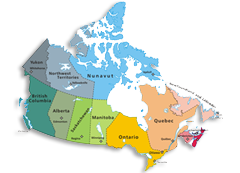Bay of Fundy
Nova Scotia, Canada
Canada's Bay of Fundy is home to the highest tides in the world. The Bay of Fundy is a 270 km (170 mile) long ocean bay that stretches between the provinces of New Brunswick and Nova Scotia on Canada's east coast.
Each day 100 billion tonnes of seawater flows in and out of the Bay of Fundy during one tide cycle more than the combined flow of the world’s freshwater rivers!
Near the head of the Bay, towering sea cliffs and sea stacks are exposed at low tide with a vertical variance that can exceed 50 feet or 15 metres. The horizontal variance between low and high tide is equally astonishing – up to 3 miles or 5 kilometers. You do, however, have to be careful when you explore the exposed ocean floor because the water can rush back in at over 10 meters per minute! As a general rule, the ocean floor is accessible for exploring three hours before and three hours after low tide. During Fundy’s low tide cycle you are literally able to walk, and explore, the ocean floor.
The region's culture and history are celebrated at Fundy inter-pretation centres, historic sites, museums, horticultural display gardens, and artisans’ studios.
Nova Scotia vacations to the Bay of Fundy should include a stop at The Joggins Fossil Centre, a UNESCO World Natural Heritage Site located near Amherst and the Nova Scotia-New Brunswick border on the Fundy Shore, where you will find the world's largest collection of 300 million-year-old fossils.
The Bay of Fundy tides are best explored at The Hopewell Rocks, where you can walk around the famous "flowerpot rocks" at low tide then watch them slowly disappear.













